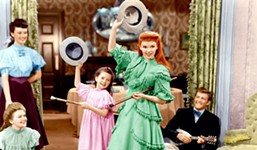
An American in Paris
1951, NR, 115 min. Directed by Vincente Minnelli. Starring Gene Kelly, Leslie Caron, Oscar Levant, Nina Foch.
REVIEWED By Marjorie Baumgarten, Fri., July 9, 1999
The Austin Film Society's current series is devoted to films whose greatness serves as a tribute to George Morris, the Film Society's mentor and "patron saint," and a former film critic for The Austin Chronicle. Excerpted here is Morris' original review of this dazzlingly original Hollywood musical. This has always been one of Minnelli's most popular movies, but even if you think you've watched it to death on TV and videotape, you have never really seen this most tragic of all the director's tragic musicals if you haven't viewed it on a big screen with its shimmering color photography by John Alton, the great noir artist, and Alfred Gilks, who shot the extraordinary 20-minute ballet that "closes" the film. Alan Jay Lerner's plot is wafer-thin, even for a musical. An ex-G.I. (Kelly) remains in Paris after the war to pursue a career as a painter. His canvases aren't so hot, though, so when an aggressive patroness (Foch) pleads to "sponsor" him, the opportunistic Kelly flashes that Irish grin and goes along for the ride. Observing, commenting on, and participating in this "love/art-for-sale" arrangement are Kelly's pal Levant, an embittered blocked concert pianist; Guetary, a French music-hall performer; and gamine Caron, the object of both Guetary and Kelly's affections. It may sound like a conventional quintet on which to hang what seems like almost every marvelous George and Ira Gershwin song ever written, not to mention Levant (a close friend of the Gershwins and one of the definitive interpreters of George's piano works) pounding out the third movement of "Concerto in F," and the tone poem that inspired the film's title and surreal ballet. An American in Paris, however, is a brooding, somber work. Like all of Minnelli's protagonists, Kelly refuses to face the truth, namely that his desire to paint is hampered by his mediocre talent. To justify his dreams of being a great artist, he imagines and bounces through a world of fantasy, a world so real to him – and to us – that his frequent outbursts of song and dance become as natural as they are imperative for emotional liberation. This vaporous paradise completely dispenses with the narrative's indications toward illusionism in the climactic ballet, a cathartic set-piece (cf., the finales of Some Came Running and Two Weeks in Another Town) that deliriously, continually re-creates and releases through movement, dance, color, and decor the tensions between Kelly and Caron that have been building throughout the film. Designed after the paintings of Dufy, Utrillo, Toulouse-Lautrec, Rousseau, and other artists that Kelly has unsuccessfully emulated in his work, this sequence is quintessential Minnelli: a heightened, swirling exploration of time and space, bustle and repose, grief and loss. The camera tracks, cranes, and dollies through the dance space, anticipating with the boldness of the greatest director working at MGM in 1951, that the New Wave is, indeed, not so very far away. Finally, like all of Minnelli's collaborations with Lerner (Brigadoon, Gigi, On a Clear Day You Can See Forever), An American in Paris is a paradox - a musical that embraces solitude and romantic despair. It is a resplendent motion picture" – George Morris (10/24/86) For more info on the series (and more reviews by Morris) see the May 28 Screens section of the Chronicle, call the AFS at 322-0145, or see www.austinfilm.org.
A note to readers: Bold and uncensored, The Austin Chronicle has been Austin’s independent news source for over 40 years, expressing the community’s political and environmental concerns and supporting its active cultural scene. Now more than ever, we need your support to continue supplying Austin with independent, free press. If real news is important to you, please consider making a donation of $5, $10 or whatever you can afford, to help keep our journalism on stands.
Marjorie Baumgarten, July 15, 2002
Marjorie Baumgarten, June 27, 2001
An American in Paris, Vincente Minnelli, Gene Kelly, Leslie Caron, Oscar Levant, Nina Foch









